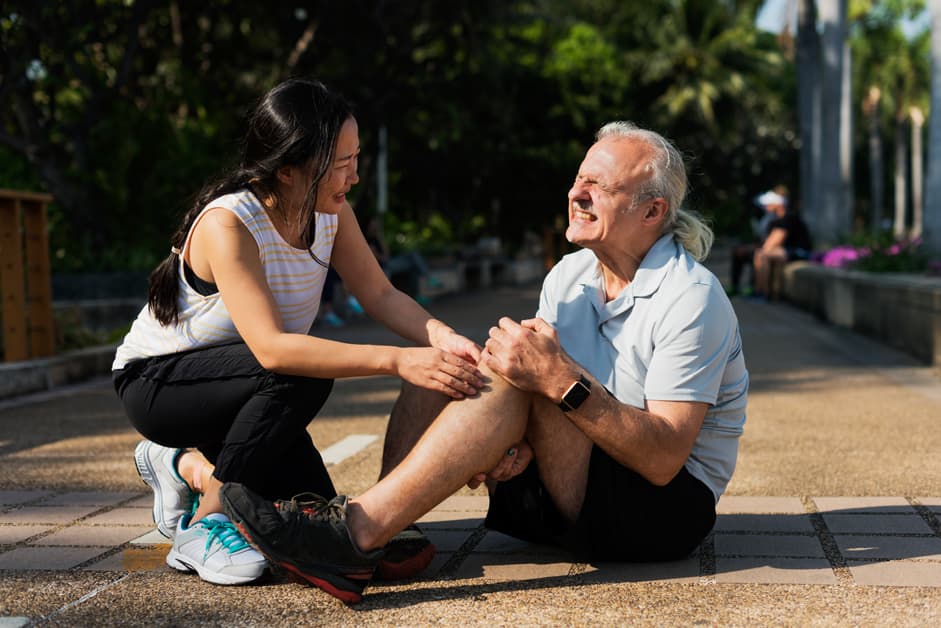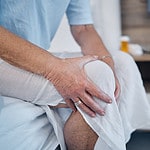Anatomy of the Knee
The knee is an intricate joint with ligaments, bones, and cartilage. It bears the weight of your body with standing, walking, sitting, running and jumping. It also helps balance your body. Knowing its anatomy is crucial to maintain its health as you age.
Overview of the knee joint
The knee joint holds three bones: femur, tibia and patella. It is the biggest joint in the body and lets movement occur in many directions. It also acts as a shock absorber, taking on the weight of activities.
To let this happen, there are several structures to give support and stability. A fibrous structure, the articular capsule, surrounds the joint and contains the synovial fluid which oils it. Additionally, ligaments are placed around the knee, like:
- Collateral ligaments on either side, preventing side-to-side motion.
- Cruciate ligaments, in front and back of the kneecap, controlling forward/backward motion.
- Patellar ligament linking the kneecap to the shinbone.
- Quadriceps tendon, which attaches four muscles at the front of the thigh bone to the kneecap.
- Meniscus (two wedge shaped cartilages) working as shock absorbers and stabilizing devices when you move or rotate your legs or feet.
The muscles around the knee in both legs are essential for proper functioning when you move or do physical activity.
Understanding the knee’s ligaments
The knee houses four ligaments that supply stability, aid, and range of motion. These include the ACL, PCL, LCL, and MCL.
- The ACL is in the middle front of the knee. It links the thighbone with the shinbone, controlling movement when you twist or turn.
- The PCL is in the back of the knee, connecting the thighbone to the shinbone. It stops backward movement and keeps the shinbone from sliding off the thighbone.
- The LCL is on the outside of the knee. It’s below the femur and above the fibula bone, keeping the bones stable when running or squatting.
- The MCL is inside your knee. It links the thighbone to the shinbone, providing a stabilizer for inward movements like kneeling or pushing off. It acts like a seat belt across a car’s roof pillar.
Common Knee Injuries
Knees often get hurt, especially when we’re getting older. Poor posture, too much exercise or using the knee joint a lot can cause injuries. These can be very uncomfortable and stop us from doing stuff.
In this article, we’ll list some of the most common knee injuries and how to avoid them:
Causes of knee pain
Knee pain is a typical issue for both the young and old. It can be due to an injury or start gradually. Common causes of knee pain include:
- Osteoarthritis: This happens when joint cartilage starts to break down due to age. Bone spurs may form and fluid can build up in the joint, leading to stiffness and inflammation.
- Runner’s Knee (Patellar Tendinitis): Doing the same activities repeatedly, like running, can wear down the patellar tendon which connects your kneecap to your shinbone. This is called runner’s knee, and it can cause a sharp pain near the kneecap that gets worse with activity.
- Patellofemoral Syndrome (Anterior Knee Pain): Too much stress on the muscles in the front of your thigh can cause instability or misalignment of the kneecap when it moves over your thighbone. This can lead to pain over time. Cycling, kneeling or running uphill can cause this.
- Meniscal Tears: The meniscus is a c-shaped piece of cartilage between the thighbone and shinbone that absorbs shock during movement. This can wear down or tear suddenly due to movement, causing pain near the injury, swelling and limited range of motion.
- Bursitis: Bursae are small sacs filled with fluid that cushion tendons from bones. When these sacs become inflamed, it can cause heat, redness, soreness and swelling around joints such as the knee, making movement difficult.
Types of knee injuries
Torn ligaments or tendons are a common type of knee injury. They happen when the tissues that support the joint become damaged. A tear can be partial or complete, and the severity and location of the tear vary. Tendon tears often come with muscle strains, due to the tendon being overstretched. Rest, ice, compression and elevation can help, but surgery might be needed for severe cases.
Meniscal tears are another type of injury. They happen from sudden movements in sports or workouts. Severe cases may need surgery. ACL injuries are common for athletes in contact sports. These cause bad damage and need surgery for proper recovery and rehabilitation.
To prevent knee injuries, warm up and do physical conditioning. Be safe when doing physical activities.
Diagnosing knee injuries
Accurately diagnosing knee injuries is vital for successful treatment. The diagnosis includes a physical examination, with tests on range of motion, strength and reflexes. Plus, diagnostic imaging such as x-rays and MRIs may be used.
The doctor will examine four areas:
- Range of motion: can the knee joints move easily without pain?
- Strength: are the muscle groups around the knee joint functioning well?
- Reflexes: the patellar and Achilles reflexes help to assess any neurological issues.
- Imaging: x-ray or MRI scans offer detailed images of the structures being examined.
Lab work may also be necessary. Blood tests and other studies can check for underlying causes of inflammation or fluid buildup in the joint. After the examination, the doctor will make a diagnosis. Then, an appropriate treatment plan for the condition can be developed.
Prevention and Treatment
Time to act! Prevention is the key to healthy knees as you age. Get those exercises in, keep a healthy weight and be mindful of activities. Treatments are also available for any existing knee problems.
Let’s dive deeper into prevention and treatment of knee issues!
Strengthening exercises
Age-related degeneration of the knee joint can make it hard to do everyday activities. To protect from discomfort and potential injury, take time to strengthen your knees. Exercises that build up muscles around your knee create a supportive shell, cushioning and protecting the joint from impact activity like running or jumping. It’s important to find an exercise program specifically for knee strengthening. This will give the best results with minimal risk for existing areas of discomfort.
Examples of good exercises for strengthening the knee:
- Squats – Target important muscle groups that support your knee joint e.g. quadriceps, hamstrings and calves.
- Lunges – Work on balance and bilateral leg strength development.
- Step ups – Lift your body weight while targeting muscle groups in legs, hips and core.
- Partial crunches/ bridges – Target inner thigh muscles which provide hip stability when carrying out daily activities.
Low impact activities like swimming or biking are also good ideas. They relieve pressure on bones and joints, while giving aerobic fitness benefits.
Stretching exercises
Stretching exercises are really important for knee health. They help increase flexibility, reduce stiffness, and strengthen the muscles that support the joint. Do a few stretching exercises 3-7 days a week to keep your knee healthy and pain-free. Make sure to hold each stretch for 20-30 seconds, and don’t push it if you feel pain or tightness.
Here are some basic stretching exercises:
- Standing quadriceps stretch: Stand tall. Bend your right leg up behind you, and grasp your ankle with your right hand. Pull your heel towards your buttocks. Feel a gentle stretch in your thigh. Hold for 20-30 seconds. Switch sides.
- Knee circles: Sit in a chair. Put your feet on the floor, hip-width apart. Place your hands on top of your right knee. Trace 10 circles in one direction. Then, trace 10 circles in the other direction. Switch sides.
- Straight leg raise: Lie on one side. Extend your legs straight out. Rest your head on an arm or use a pillow. Lift your top leg off the floor. Don’t arch your back or lean forward. Hold for 20-30 seconds. Change sides.
- Clamshells: Lie on one side. Stack your legs, propped up high with pillows. Open your top leg away from the other. Use a towel for more stability. Hold for 10 seconds. Close slowly, contracting your core muscles. Repeat 8 times. Then, switch sides.
Wearing proper footwear
The significance of wearing shoes that fit comfortably and properly cannot be over-emphasized. From twenty-year-olds to seventy-year-olds, the type of shoes you wear can have a big impact on your knee health. Shoes that don’t offer sufficient support or are weak can lead to pain and swelling in the knees and other body parts.
When selecting new shoes for your knees, go for ones that are cushioned and supportive with wide toe boxes. This helps to spread the weight evenly across your feet. If you buy sports shoes, make sure to get the ones suited to the precise activity. High-heeled shoes should be avoided as they weaken stability and add pressure to the ankle and knee joints.
You should also change shoes regularly – Americans buy a new pair of shoes every 18 months. This is to make sure they still give the necessary cushioning and support, as the materials tend to break down over time. Wearing appropriate shoes is a great way to preserve your knee health, regardless of your age!
Diet and Lifestyle
Want to have healthy knees? Positive changes in your diet and lifestyle can help. The secret is to get the right nutrition and do activities to defend and strengthen your knees.
Learn tips and strategies here to keep your knees in good condition as you age.
Eating a healthy diet
Eating healthy is essential for a healthier lifestyle. There’s no one-size-fits-all diet, but what matters is the quality of the food you choose. Eating healthily means picking nutrient-rich foods like veggies, whole grains, and lean proteins over meals high in sugar and saturated fat.
When selecting foods to add to your diet, choose minimally processed options such as fresh fruit and veg, whole grains like oats and quinoa, and lean proteins like fish or chicken breast. Avoid heavily processed snacks with trans fats or refined sugars – chips, cookies, that sort of thing.
Making an entirely new menu can be tough, so why not grab some ideas from recipes you find online, in cookbooks, or magazines? Also, the Dietary Guidelines for Americans 2020–2025 suggest getting variety from different food groups each day for better health outcomes.
Or, if you need more help, why not talk to a dietitian and get a personalized meal plan tailored to you?
Maintaining a healthy weight
Achieving and keeping a healthy weight takes dedication, consistency, and effort. Make changes to your lifestyle, like eating better and exercising more. Fad diets may help you lose weight fast, but they are hard to keep up with. Eat foods that are nutritious and full of fiber, like fruits, vegetables, whole grains, lean proteins and healthy fats.
For many, physical activity is important to maintain a healthy weight. Do moderate intensity activities like walking, jogging or cycling. Or do vigorous activities like swimming or strength training. Exercise 4 times a week for 30 minutes. If this isn’t possible, exercise in 10 minute intervals.
Talk to medical professionals if you have health issues. Obesity can be linked to mental health issues like stress or depression. Counseling can help improve mental health symptoms, which makes it easier to eat and live healthily. If you have hormonal imbalances, talk to your doctor. They will guide you on medications or other remedies.
Reducing inflammation
Inflammation is a problem when aging, and must be reduced. It’s caused by an imbalance between the body’s anti- and pro-inflammatory processes. This causes swelling, pain and can damage healthy cartilage and tissue.
To reduce inflammation there are certain diet and lifestyle changes you can make:
- Eat foods rich in unsaturated fats, like fish, nuts, seeds and avocados.
- Omega-3 fatty acids are also beneficial, and can be found in supplements from health food stores or online.
Stress increases cortisol which causes inflammation. Exercise, such as stretching or low impact activities like cycling, can reduce stress. Yoga and Pilates classes are also good for joint mobility, and can help with range of motion.
When to See a Doctor
Ageing brings potential health risks. If you’re in pain or having problems with mobility, it’s time to talk to your doctor.
This section focuses on when seeing a doctor for knee issues is important:
Warning signs of serious injury
Sometimes, a knee injury can be worse than it looks. Even small joint pain, swelling, instability, or not being able to stand with the knee, can mean a serious injury. Here are signs that you should go to a doctor:
- Pain that won’t go away
- Not being able to stand on the hurt area
- Numbness or tingling near the injury
- Pain with regular “catching” or “locking” in the knee joint
- Swelling that does not heal in 72 hours
- Bruising and misshaping of the joint
- Knee joint being unstable and difficulty walking without help or a brace.
If any of these signs appear, it’s important to go to a doctor quickly. They can evaluate your condition and give you options for long-term health.
When to seek medical attention
If you have:
- Pain that last more than a day or two in the knee
- Swelling with redness or warmth around the knee
- Weak leg muscles
- Trouble walking normally
- Popping, pressure, or pain when you move the joint
You must get medical help! Knee issues can be serious. Your doctor will look at what is causing your discomfort and give you advice.
Frequently Asked Questions
Q1. What are the best exercises to keep my knees healthy as I age?
A1. The best exercises to keep your knees healthy as you age include low-impact activities like swimming, using an elliptical, and biking. Additionally, strength training exercises like squats, lunges, and step-ups are also beneficial for building knee strength and stability.
Q2. What lifestyle changes can I make to protect my knees?
A2. Lifestyle changes that can help protect your knees include maintaining a healthy weight, eating a balanced diet, and avoiding activities that involve heavy impact on your joints. Additionally, stretching and strengthening exercises can help improve knee stability and strength.
Q3. What are some tips for protecting my knees while exercising?
A3. When exercising, it is important to use proper form and technique. Additionally, it is important to warm up and cool down before and after your workout. Additionally, it is important to avoid activities that involve heavy impact on your knees, such as running and jumping.





